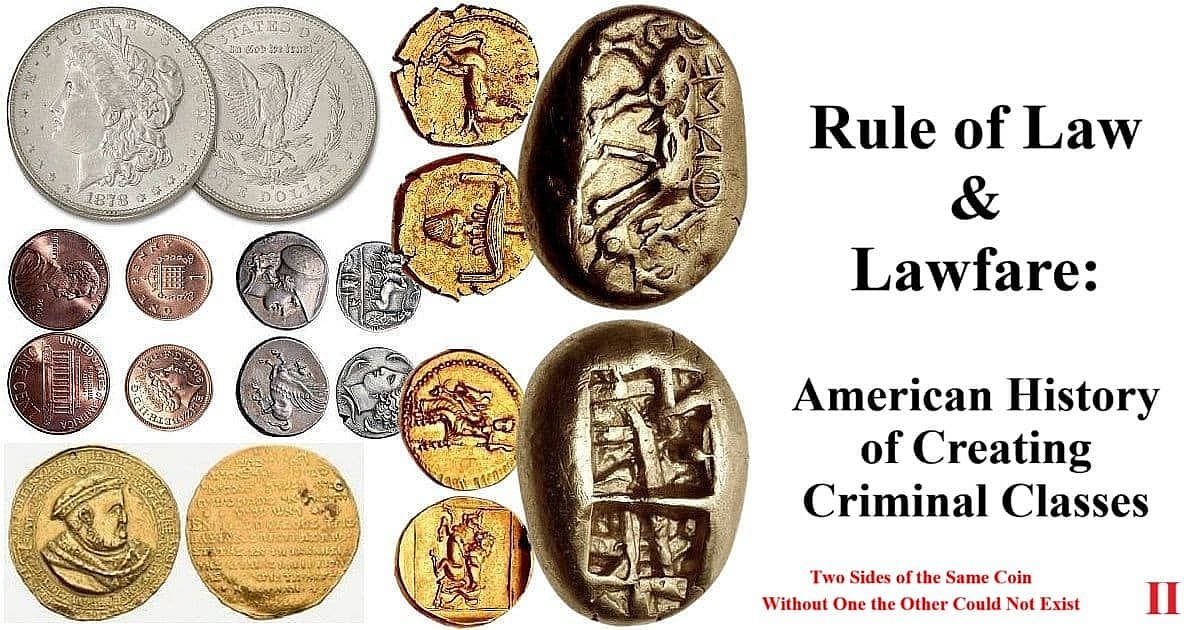Bottom Line Up Front:
Rule of law became America’s favorite weapon for creating instant criminals out of entire ethnic groups – Chinese with opium, Mexicans with marijuana, Catholics with alcohol, and Black Americans with heroin. While lawfare dates back to ancient times, America’s drug-based version has been the playbook for 150 years.
America perfected the art of weaponizing law enforcement long before anyone coined the term “lawfare.” The pattern is brutally simple: identify a group you want to control, associate them with a substance, criminalize that substance, then use selective enforcement to destroy their communities. It’s not conspiracy theory when Nixon’s own advisor admitted it in a 1994 interview.
The Chinese and Opium: America’s First Drug War (1870s-1880s)
San Francisco passed America’s first anti-drug law in 1875, targeting opium dens specifically in Chinese neighborhoods. The timing wasn’t coincidental – Chinese workers had just finished building the transcontinental railroad and were now competing for jobs with white workers. The 1875 ordinance banning opium dens was the nation’s first anti-drug law, followed by twenty-two states prohibiting opium dens by 1896.
The federal government jumped in with the Angell Treaty of 1880, which banned Chinese nationals from importing smoking-opium into the United States. Here’s the kicker: smoking opium was pharmacologically identical to the opium derivatives white Americans were buying in patent medicines. The only difference? Who was using it.
The pattern of selective enforcement was clear. Between 1870 and 1889 there was a net outflow of Chinese, yet opium imports jumped an extraordinary 27%. The laws weren’t about stopping drug use – they were about creating a legal framework to harass, arrest, and deport Chinese immigrants whenever convenient.
Mexican Immigrants and Marijuana: Manufacturing the “Killer Weed” (1910s-1930s)
The Mexican Revolution of 1910 brought waves of refugees north, and with them came the recreational use of cannabis – which Americans had been buying as medicine for decades. The plant wasn’t new; the people using it were. Police officers in Texas claimed that marijuana incited violent crimes, aroused a “lust for blood,” and gave its users “superhuman strength”.
The Name Game
Americans knew cannabis – it was in their medicine cabinets. So authorities rebranded it “marihuana” to make it sound foreign and dangerous. The term cannabis was largely replaced by the Anglicized marijuana, which some speculated was done to promote the foreignness of the drug and thus stoke xenophobia.
State after state criminalized marijuana between 1914 and 1925, with California’s 1907 Poison Act leading the charge. The federal Marihuana Tax Act of 1937 finished the job, effectively criminalizing cannabis nationwide. Harry Anslinger, head of the Federal Bureau of Narcotics, pushed propaganda claiming Mexicans were giving this “killer weed” to white schoolchildren.
Prohibition and the Catholic “Menace” (1920s)
Prohibition wasn’t just about alcohol – it was about who was drinking it. The Women’s Christian Temperance Union and Anti-Saloon League explicitly blamed Catholic immigrants for America’s “saloon culture.” They believed that if they didn’t push for a constitutional prohibition before the 1920 census, and before congressional districts were reapportioned based on population increase, that they wouldn’t be able to get prohibition because there’d be too many acculturated new citizens.
Enter the Klan
The KKK’s 1920s revival wasn’t primarily about Black Americans – it was about Catholics and immigrants. The Klan—along with its auxiliary “Women of the Ku Klux Klan” and three KKK youth groups—spread across the north and south by arguing that Catholics and immigrants were breaking Prohibition.
The Klan didn’t just advocate for Prohibition; they enforced it through vigilante violence. In 1923, in Williamson County, Illinois, hundreds of enforcers, many of them Klansmen, began a series of violent raids on distilleries, bars, and private homes, in which several hundred people were arrested and more than a dozen were killed.
The federal Prohibition Bureau sometimes deputized Klan members to expand their enforcement ranks. Rule of law and lawfare merged into state-sanctioned terrorism against Catholic communities.
Nixon’s Confession: Rule of Law as Lawfare (1970s)
Here’s where the mask comes completely off. John Ehrlichman, Nixon’s domestic policy advisor, admitted in 1994 exactly what the War on Drugs was about:
“The Nixon campaign in 1968, and the Nixon White House after that, had two enemies: the antiwar left and black people. You understand what I’m saying? We knew we couldn’t make it illegal to be either against the war or black, but by getting the public to associate the hippies with marijuana and blacks with heroin”.
The confession continues: “and then criminalizing both heavily, we could disrupt those communities”. They could arrest leaders, raid homes, break up meetings, and vilify them on the evening news. “Did we know we were lying about the drugs? Of course we did”.
The Numbers Don’t Lie
Before Nixon’s drug war, America’s male incarceration rate was stable at about 200 per 100,000 for fifty years. By 1986, about a decade after the War on Drugs started locking up drug users and dealers in cages, the male incarceration rate doubled to 400 per 100,000 population. By 2008, it hit nearly 1,000 per 100,000 – a five-fold increase.
The Pattern Repeats
Each wave followed the same playbook:
- Target Selection: Choose an ethnic or political group seen as threatening to power
- Substance Association: Link that group to a specific drug through propaganda
- Legal Framework: Pass laws criminalizing the substance with harsh penalties
- Selective Enforcement: Apply laws primarily against the target population
- Community Disruption: Use arrests to break up families, deport immigrants, suppress voters
The substances changed – opium, marijuana, alcohol, heroin – but the strategy remained constant. Rule of law provided the weapon; lawfare determined the targets.
Modern Implications
Today’s drug laws still show these patterns. Black and Latinx people are far more likely than white people to be stopped, searched, arrested, convicted, harshly sentenced, and saddled with a lifelong criminal record, despite similar usage rates across racial lines.
The difference between medicine and menace, between legal and illegal, between citizen and criminal, has never been about the substances themselves. It’s always been about who’s using them.
The blindness to rule of law as lawfare continues across political lines. Many MAGA blogs and news sites automatically accept FBI raids on Trump critics like Bolton as legitimate “rule of law” enforcement. The New Neo’s recent post, “A raid on Bolton,” highlights this pattern perfectly.
The same selective enforcement that destroyed Chinese, Mexican, and Black communities now gets weaponized in political battles. Americans cheer when lawfare targets enemies, cry victim when it targets allies. Yet many still can’t see the connection.
Outro
America’s history of rule of law reveals an uncomfortable truth: laws designed to “protect society” have consistently been weapons aimed at specific communities. From Chinese opium smokers to Mexican cannabis users, from Catholic bootleggers to Black heroin addicts, the pattern is undeniable – admitted to by the very architects of these policies.
Nixon’s advisor confessed what historians had long suspected: the drug war was never about drugs. It was about using rule of law as lawfare against political enemies and minority communities. The substances were just the excuse; control was always the goal.
As we saw in Part 1, this pattern of weaponizing law isn’t new – it stretches back to Hammurabi’s Code. But America refined it into an art form, creating instant criminals based on ethnicity and politics.
Part 3 will examine how both Republicans and Democrats continue this tradition today, wielding DOJ power while crying victim when the same tactics target them. The hypocrisy isn’t new – it’s the American way of lawfare, refined over 150 years of practice.

